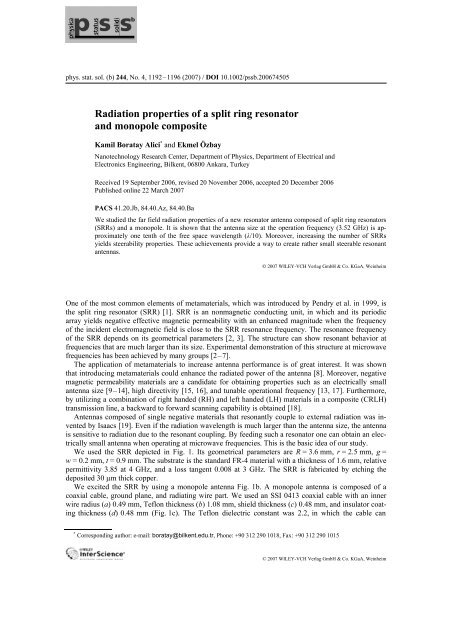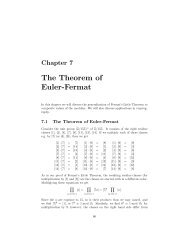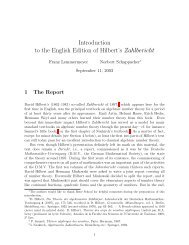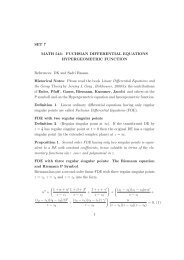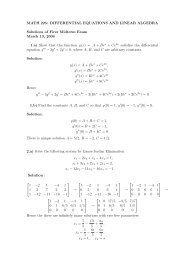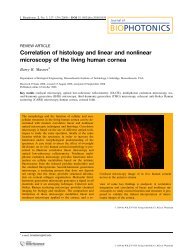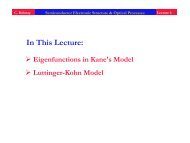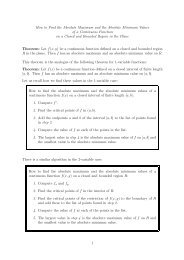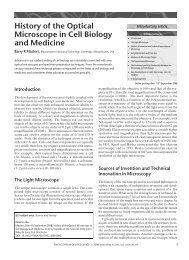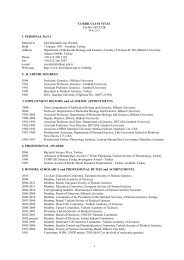Radiation properties of a split ring resonator and monopole composite
Radiation properties of a split ring resonator and monopole composite
Radiation properties of a split ring resonator and monopole composite
Create successful ePaper yourself
Turn your PDF publications into a flip-book with our unique Google optimized e-Paper software.
phys. stat. sol. (b) 244, No. 4, 1192–1196 (2007) / DOI 10.1002/pssb.200674505<br />
<strong>Radiation</strong> <strong>properties</strong> <strong>of</strong> a <strong>split</strong> <strong>ring</strong> <strong>resonator</strong><br />
<strong>and</strong> <strong>monopole</strong> <strong>composite</strong><br />
Kamil Boratay Alici * <strong>and</strong> Ekmel Özbay<br />
Nanotechnology Research Center, Department <strong>of</strong> Physics, Department <strong>of</strong> Electrical <strong>and</strong><br />
Electronics Enginee<strong>ring</strong>, Bilkent, 06800 Ankara, Turkey<br />
Received 19 September 2006, revised 20 November 2006, accepted 20 December 2006<br />
Published online 22 March 2007<br />
PACS 41.20.Jb, 84.40.Az, 84.40.Ba<br />
We studied the far field radiation <strong>properties</strong> <strong>of</strong> a new <strong>resonator</strong> antenna composed <strong>of</strong> <strong>split</strong> <strong>ring</strong> <strong>resonator</strong>s<br />
(SRRs) <strong>and</strong> a <strong>monopole</strong>. It is shown that the antenna size at the operation frequency (3.52 GHz) is approximately<br />
one tenth <strong>of</strong> the free space wavelength (λ/10). Moreover, increasing the number <strong>of</strong> SRRs<br />
yields steerability <strong>properties</strong>. These achievements provide a way to create rather small steerable resonant<br />
antennas.<br />
© 2007 WILEY-VCH Verlag GmbH & Co. KGaA, Weinheim<br />
One <strong>of</strong> the most common elements <strong>of</strong> metamaterials, which was introduced by Pendry et al. in 1999, is<br />
the <strong>split</strong> <strong>ring</strong> <strong>resonator</strong> (SRR) [1]. SRR is an nonmagnetic conducting unit, in which <strong>and</strong> its periodic<br />
array yields negative effective magnetic permeability with an enhanced magnitude when the frequency<br />
<strong>of</strong> the incident electromagnetic field is close to the SRR resonance frequency. The resonance frequency<br />
<strong>of</strong> the SRR depends on its geometrical parameters [2, 3]. The structure can show resonant behavior at<br />
frequencies that are much larger than its size. Experimental demonstration <strong>of</strong> this structure at microwave<br />
frequencies has been achieved by many groups [2–7].<br />
The application <strong>of</strong> metamaterials to increase antenna performance is <strong>of</strong> great interest. It was shown<br />
that introducing metamaterials could enhance the radiated power <strong>of</strong> the antenna [8]. Moreover, negative<br />
magnetic permeability materials are a c<strong>and</strong>idate for obtaining <strong>properties</strong> such as an electrically small<br />
antenna size [9–14], high directivity [15, 16], <strong>and</strong> tunable operational frequency [13, 17]. Furthermore,<br />
by utilizing a combination <strong>of</strong> right h<strong>and</strong>ed (RH) <strong>and</strong> left h<strong>and</strong>ed (LH) materials in a <strong>composite</strong> (CRLH)<br />
transmission line, a backward to forward scanning capability is obtained [18].<br />
Antennas composed <strong>of</strong> single negative materials that resonantly couple to external radiation was invented<br />
by Isaacs [19]. Even if the radiation wavelength is much larger than the antenna size, the antenna<br />
is sensitive to radiation due to the resonant coupling. By feeding such a <strong>resonator</strong> one can obtain an electrically<br />
small antenna when operating at microwave frequencies. This is the basic idea <strong>of</strong> our study.<br />
We used the SRR depicted in Fig. 1. Its geometrical parameters are R = 3.6 mm, r = 2.5 mm, g =<br />
w = 0.2 mm, t = 0.9 mm. The substrate is the st<strong>and</strong>ard FR-4 material with a thickness <strong>of</strong> 1.6 mm, relative<br />
permittivity 3.85 at 4 GHz, <strong>and</strong> a loss tangent 0.008 at 3 GHz. The SRR is fabricated by etching the<br />
deposited 30 µm thick copper.<br />
We excited the SRR by using a <strong>monopole</strong> antenna Fig. 1b. A <strong>monopole</strong> antenna is composed <strong>of</strong> a<br />
coaxial cable, ground plane, <strong>and</strong> radiating wire part. We used an SSI 0413 coaxial cable with an inner<br />
wire radius (a) 0.49 mm, Teflon thickness (b) 1.08 mm, shield thickness (c) 0.48 mm, <strong>and</strong> insulator coating<br />
thickness (d) 0.48 mm (Fig. 1c). The Teflon dielectric constant was 2.2, in which the cable can<br />
* Corresponding author: e-mail: boratay@bilkent.edu.tr, Phone: +90 312 290 1018, Fax: +90 312 290 1015<br />
© 2007 WILEY-VCH Verlag GmbH & Co. KGaA, Weinheim
Original<br />
Paper<br />
phys. stat. sol. (b) 244, No. 4 (2007) 1193<br />
Fig. 1 (online colour at: www.pss-b.com) a) Schematics <strong>of</strong> a <strong>split</strong> <strong>ring</strong> <strong>resonator</strong> (SRR). b) Schematics<br />
<strong>of</strong> the SRR inserted <strong>monopole</strong> antenna. c) Schematics <strong>of</strong> the coaxial cable. d) Measured S11 for the<br />
<strong>monopole</strong> source <strong>and</strong> <strong>monopole</strong> SRR <strong>composite</strong>.<br />
transmit the TEM mode waves up to 65 GHz safely. The ground plane material is aluminum <strong>and</strong> is connected<br />
to the shield by a conducting paste. It is 0.5 mm thick <strong>and</strong> has a square shape with an edge length<br />
that is equal to the free space wavelength. The operation frequency was 3.52 GHz, which was determined<br />
by conside<strong>ring</strong> the SRR’s geometrical parameters. The corresponding free space wavelength (λ)<br />
was 85.17 mm. The length <strong>of</strong> the wire above the ground plane was 8.32 mm <strong>and</strong> for the <strong>monopole</strong> antenna<br />
this length corresponds to a quarter <strong>of</strong> the operation wavelength. Thus this <strong>monopole</strong> antenna was<br />
working efficiently when feed wavelength was 33.28 mm <strong>and</strong> feed frequency was 7.8 GHz. Therefore,<br />
the SRR resonance frequency is smaller than the <strong>monopole</strong> operation frequency. The SRR is positioned<br />
rather close to the radiating wire part <strong>of</strong> the <strong>monopole</strong> antenna.<br />
At the operation frequency, 3.52 GHz, the wire part <strong>and</strong> SRR behave as a <strong>composite</strong> radiating structure.<br />
The characteristic impedance <strong>of</strong> the coaxial cable <strong>and</strong> wire SRR <strong>composite</strong> becomes very close, in<br />
which the surface currents on the SRR increase an order <strong>of</strong> magnitude <strong>and</strong> the structure starts to radiate<br />
efficiently.<br />
For the theoretical calculations, we simulated the structure via the commercial program: Computer<br />
Simulation Technology Microwave Studio (CST MWS). There was a considerable change at the S11 <strong>and</strong><br />
at the surface current at the operation frequency with respect to a nonresonant frequency. S11 reduced to<br />
–30 dB from –3 dB <strong>and</strong> the surface current increased from 90 A/m to 2460 A/m. For the experimental<br />
demonstration, we used an HP8510C Network Analyzer. After a full two port calibration we measured<br />
the <strong>monopole</strong> antenna S11 in order to determine its efficient operation frequency, which is 7.8 GHz.<br />
Subsequently, we measured the S11 parameter between 3 GHz <strong>and</strong> 5 GHz (Fig. 1d). We observed that<br />
the <strong>composite</strong> to be a –32 dB S11 value.<br />
www.pss-b.com © 2007 WILEY-VCH Verlag GmbH & Co. KGaA, Weinheim
1194 K. B. Alici <strong>and</strong> E. Özbay: <strong>Radiation</strong> <strong>properties</strong> <strong>of</strong> a SRR <strong>and</strong> <strong>monopole</strong> <strong>composite</strong><br />
Fig. 2 (online colour at: www.pss-b.com) Far field pattern <strong>of</strong> the SRR <strong>monopole</strong> <strong>composite</strong>: a) 3D view, c) E plane<br />
(x–y plane), d) H plane (y–z plane). b) Far field pattern <strong>of</strong> the <strong>monopole</strong> (3D view).<br />
We also obtained the far field radiation patterns <strong>of</strong> the structure by using the simulation results. The<br />
structure radiates similar to a single element patch antenna. The 3D far field view <strong>and</strong> corresponding<br />
E plane <strong>and</strong> H plane patterns are shown in Fig. 2. Main lobe direction was 115°, <strong>and</strong> the directivity is<br />
6.53 dBi. In order to show that the effect is purely due to the magnetic resonance <strong>of</strong> the SRR, we also<br />
reveal the closed <strong>split</strong> <strong>ring</strong> <strong>resonator</strong> (CRR) results. CRR has the same parameters as SRR but the <strong>split</strong>s<br />
are closed. We consider the same planes as the SRR <strong>monopole</strong> <strong>composite</strong>. The CRR insertion does not<br />
have an effect on the <strong>monopole</strong>, on the other h<strong>and</strong>, SRR insertion entirely changes the antenna characteristics,<br />
such as the radiation pattern.<br />
In order to estimate the radiation efficiency <strong>of</strong> the antennas we performed the absolute-gain measurements<br />
[20]. The gain <strong>of</strong> the SRR <strong>monopole</strong> <strong>composite</strong> antenna is found by compa<strong>ring</strong> it with a st<strong>and</strong>ard<br />
horn antenna. Two-antenna method is applied <strong>and</strong> the gain <strong>of</strong> the 1 SRR <strong>monopole</strong> <strong>composite</strong> is found as<br />
2.35 at 3.62 GHz. At this frequency we had minimum insertion loss (S11). The far field radiation pattern<br />
cuts are measured by the aid <strong>of</strong> the horn receiver antenna. The half-power beamwidths <strong>of</strong> the E <strong>and</strong> H<br />
plane patterns implied the directivity <strong>of</strong> the antenna as 5.48 dBi [20]. And finally we estimated the effi-<br />
© 2007 WILEY-VCH Verlag GmbH & Co. KGaA, Weinheim www.pss-b.com
Original<br />
Paper<br />
phys. stat. sol. (b) 244, No. 4 (2007) 1195<br />
Fig. 3 (online colour at: www.pss-b.com) Schematics <strong>of</strong> 3 SRRs <strong>monopole</strong> <strong>composite</strong>. b) Measured S11 data for<br />
several number <strong>of</strong> SRRs <strong>and</strong> <strong>monopole</strong>.<br />
ciency as 42.88%. For the multi SRR cases measured gains were almost the same as 1 SRR case. The<br />
simulations <strong>of</strong> the multi SRR cases show that directivity <strong>of</strong> these antennas is almost the same as the<br />
1 SRR case also. Therefore we can safely conclude that efficiencies <strong>of</strong> the multi SRR <strong>and</strong> 1 SRR antennas<br />
have similar values. These results indicate that the <strong>composite</strong> antenna has good coupling efficiency<br />
<strong>and</strong> enough radiation efficiency.<br />
One <strong>of</strong> the promising <strong>properties</strong> <strong>of</strong> the SRR <strong>monopole</strong> <strong>composite</strong> is its size. Without conside<strong>ring</strong> the<br />
ground plane, one should have a λ/2 antenna size for efficient coupling <strong>and</strong> radiation. On the other h<strong>and</strong>,<br />
for our <strong>composite</strong> structure the antenna size was approximately λ/10. We can state that this antenna is<br />
electrically small; moreover, by modifying the SRR structure in terms <strong>of</strong> capacitor loading the antenna<br />
size could even be reduced to λ/40. This work will be addressed in another paper.<br />
We also considered multi-SRR effects on the radiation pattern. By coupling 2, 3, <strong>and</strong> 4 SRRs side by<br />
side, we calculated the radiation patterns. The dependence <strong>of</strong> coupling on the arrangement <strong>of</strong> the SRRs<br />
was studied in the literature [21]. Here, SRRs are placed side by side with an 8.8 mm period (Fig. 3). The<br />
Fig. 4 (online colour at: www.pss-b.com) Multi SRR effects. a) 2 SRRs (main lobe direction = 110°). b) 4 SRRs<br />
(main lobe direction = 100°).<br />
www.pss-b.com © 2007 WILEY-VCH Verlag GmbH & Co. KGaA, Weinheim
1196 K. B. Alici <strong>and</strong> E. Özbay: <strong>Radiation</strong> <strong>properties</strong> <strong>of</strong> a SRR <strong>and</strong> <strong>monopole</strong> <strong>composite</strong><br />
measured <strong>and</strong> simulated S11 parameters indicated that the arrangement <strong>of</strong> multi-SRRs in this way does<br />
not change the operation frequency consirerably. There is a small shift with respect to the 1 SRR case.<br />
Metamaterial transmission lines can implement steerable leaky wave antennas [22–24]. We observed<br />
that by increasing the number <strong>of</strong> SRRs in the x direction, the E plane beam maximum shifts considerably.<br />
The corresponding E plane far field patterns are shown in Fig. 4. Therefore, by changing the <strong>resonator</strong><br />
numbers in the antenna, we can attain the steerability property.<br />
In conclusion, the <strong>monopole</strong> <strong>and</strong> SRR <strong>composite</strong> behaves like an electrically small antenna (λ/10)<br />
operating at the resonance frequency <strong>of</strong> the SRR. This antenna can be used instead <strong>of</strong> the planar patch<br />
antennas in some applications. Secondly, by introducing multi-SRRs we can observe the beam direction<br />
shifts. This property might lead us to steerable antennas that are composed <strong>of</strong> SRRs.<br />
Acknowledgements This work is supported by the European Union under the projects EU-DALHM, EU-NOE-<br />
METAMORPHOSE, EU-NOE-PHOREMOST, <strong>and</strong> TUBITAK under Projects Nos. 104E090, 105E066, 105A005.<br />
One <strong>of</strong> the authors (Ekmel Özbay) also acknowledges partial support from the Turkish Academy <strong>of</strong> Sciences.<br />
References<br />
[1] J. B. Pendry, A. J. Holden, D. J. Robbins, <strong>and</strong> J. W. Stewart, IEEE Trans. Microw. Theory Tech. 47, 2075<br />
(1999).<br />
[2] Y. J. Hsu, Y. C. Huang, J. S. Lih, <strong>and</strong> J. L. Chern, J. Appl. Phys. 96, 1979 (2004).<br />
[3] K. Aydin, I. Bulu, K. Guven, M. Kafesaki, C. M. Soukoulis, <strong>and</strong> E. Ozbay, New J. Phys. 7, 168 (2005).<br />
[4] D. R. Smith, Willie J. Padilla, D. C. Vier, S. C. Nemat-Nasser, <strong>and</strong> S. Schultz, Phys. Rev. Lett. 84, 4184<br />
(2000).<br />
[5] A. A. Houck, J. B. Brock, <strong>and</strong> I. L. Chuang, Phys. Rev. Lett. 90, 137401 (2003).<br />
[6] H. O. Moser, B. D. F. Casse, O. Wilhelmi, <strong>and</strong> B. T. Saw, Phys. Rev. Lett. 94, 063901 (2005).<br />
[7] K. Aydin, K. Guven, M. Kafesaki, L. Zhang, C. M. Soukoulis, <strong>and</strong> E. Ozbay, Opt. Lett. 29, 2623 (2004).<br />
[8] R. W. Ziolkowski <strong>and</strong> A. Kipple, IEEE Trans. Antennas Propag. 51, 2626 (2003).<br />
[9] M. Karkkainen, M. Ermutlu, S. Maslovski, P. Ikonen, <strong>and</strong> S. Tretyakov, 2005 IEEE International Workshop on<br />
Antenna Technology: Small Antennas <strong>and</strong> Novel Metamaterials (IEEE, 2005), p. 395.<br />
[10] P. Ikonen, M. Karkkainen, <strong>and</strong> S. Tretyakov, IEEE Antennas <strong>and</strong> Propagation Society International Symposium<br />
(IEEE, 2005), vol. 2A, p. 606.<br />
[11] M. E. Ermutlu, C. R. Simovski, M. K. Karkkainen, P. Ikonen, S. A. Tretyakov, <strong>and</strong> A. A. Sochava, 2005 IEEE<br />
International Workshop on Antenna Technology: Small Antennas <strong>and</strong> Novel Metamaterials (IEEE, 2005),<br />
p. 87.<br />
[12] S. Hrabar, J. Bartolic, <strong>and</strong> Z. Sipus, IEEE Trans. Antennas Propag. 53, 110 (2005).<br />
[13] K. Buell, H. Mosallaei, <strong>and</strong> K. Sarab<strong>and</strong>i, IEEE Trans. Microw. Theory Tech. 54, 135 (2006).<br />
[14] F. Qureshi, M. A. Antoniades, G. V. Eleftheriades, IEEE Antennas Wirel. Propag. Lett. 4, 333 (2005).<br />
[15] B. Wu, W. Wang, J. Pacheco, X. Chen, J. Lu, T. M. Grzegorczyk, J. A. Kong, P. Kao, P. A. Theophelakes, <strong>and</strong><br />
M. J. Hogan, Microw. Opt. Tech. Lett. 48, 680 (2006).<br />
[16] I. Bulu, H. Caglayan, K. Aydin, <strong>and</strong> E. Ozbay, New J. Phys. 7, 223 (2005).<br />
[17] S. Lim, C. Caloz, <strong>and</strong> T. Itoh, IEEE Trans. Microw. Theory Tech. 53, 161 (2005).<br />
[18] L. Liu, C. Caloz, <strong>and</strong> T. Itoh, Electron. Lett. 38, 1414 (2002).<br />
[19] E. D. Isaacs, P. M. Platzman, <strong>and</strong> J. T. Shen, Resonant Antennas, US Patent 6,879,298 (2005).<br />
[20] C. A. Balanis, Antenna Theory: Analysis <strong>and</strong> Design (John Wiley & Sons Inc., New York, 1997), chaps. 2, 16.<br />
[21] P. G. Balmaz <strong>and</strong> O. J. F. Martin, J. Appl. Phys. 92, 2929 (2002).<br />
[22] D. F. Sievenpiper, Steerable leaky wave antenna capable <strong>of</strong> both forward <strong>and</strong> backward direction, US Patent<br />
Application 20040227668 (2004).<br />
[23] A. Lai, C. Caloz, <strong>and</strong> T. Itoh, IEEE Microw. Mag. 5, 34 (2004).<br />
[24] A. Grbic <strong>and</strong> G.V. Eleftheriades, J. Appl. Phys. 92, 5930 (2002).<br />
© 2007 WILEY-VCH Verlag GmbH & Co. KGaA, Weinheim www.pss-b.com


